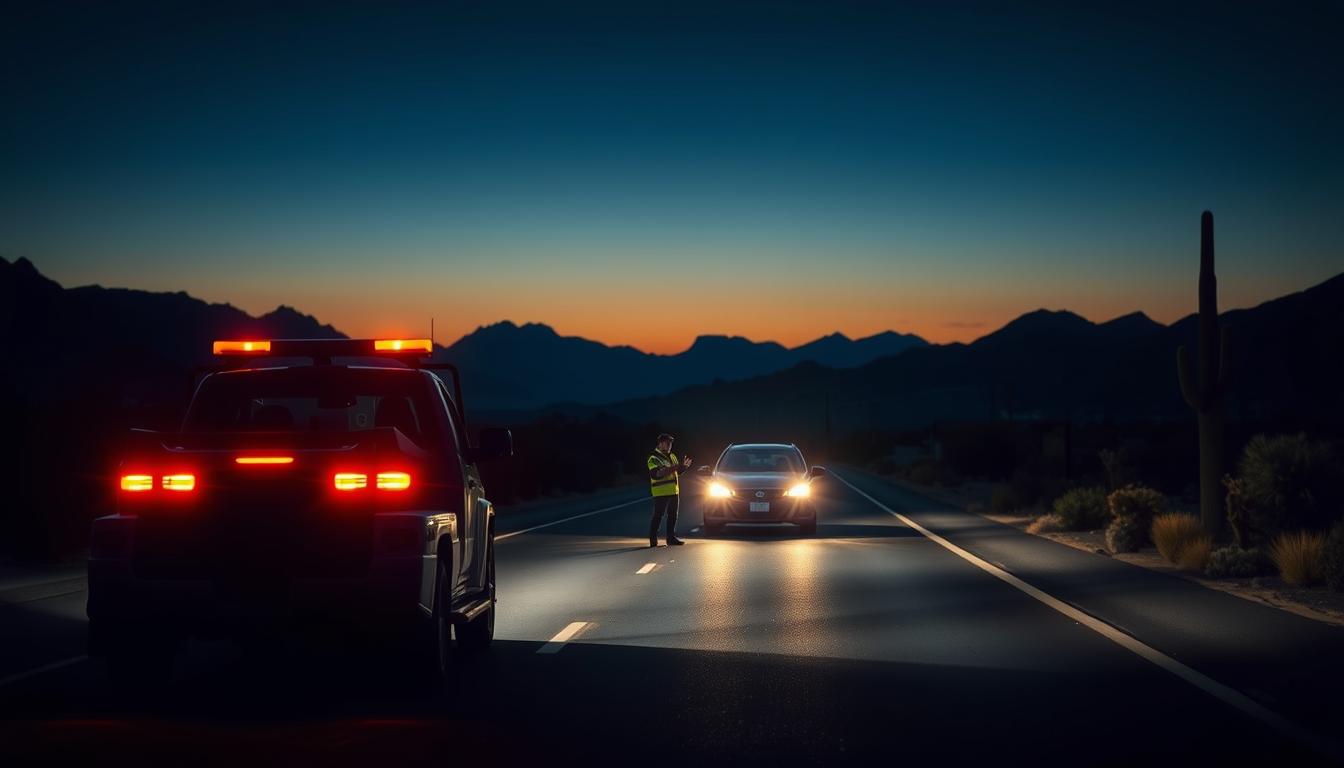
Ever found yourself stranded on a Phoenix highway with a dead battery or flat tire? You’re not alone. Thousands of drivers face vehicle breakdowns weekly in Arizona’s heat. Modern roadside service solutions now offer faster, smarter ways to get back on the road.Tire Change
Professional help arrives within an hourLugnut Removal for most emergencies, from lockouts to fuel delivery. Service providers like State Farm and GEICO provide plans starting at $14/year – cheaper than a single tow truck call. Tech upgrades let you track providers in real time through apps, just like Uber for car troubles.Lockout Service
Phoenix’s unique challenges demand specialized support. Scorching summers drain batteries faster, while monsoons create slick roads. That’s why local teams like Jump StartsQuik Pik TowingFuel Delivery train for desert conditions. Their crews handle everything from jump-starts to off-road recoveries across I-10 and Loop 202, ensuring customers receive prompt assistance.Flat Tire Repair
Locked out during a grocery run? Battery ReplacementEZ3 Roadside PhoenixRoadside Assistance experts can pop your door open without damage. Most solutions happen where you’re stuck – 75% of calls don’t require towing. With 24/7 availability and transparent pricing, you’ll never pay extra for nighttime or weekend help, thanks to clear terms in your policy.Towing Service
When your vehicle fails in scorching heat, quick support isn’t just convenient—it’s essential. Local experts deliver solutions tailored to Arizona’s extreme conditions, combining speed with specialized skills. Let’s explore how these services protect both your time and wallet.About
Phoenix’s 115°F days demand rapid solutions. Most roadside assistance providers reach drivers within Contact60 minutes —faster than baking in a broken-down car. Trained technicians handle everything from jump-starts to tire changes while you wait safely.
| Provider480-710-5902 | Avg. Response Time | Service Area |
|---|---|---|
| State Farm Partners | 47 minutes | Entire Metro Phoenix |
| GEICO NetworkGet Started | 53 minutes | 25-mile radius |
| Local Specialists |
| Basic | ||
| Color-Coded Status | Green/Yellow/Red | Single Alert |
| Digital Service Report | Full History | Basic Summary |
These systems automatically share your location through satellite positioning. Dispatchers see exactly where you’re stranded—even if you’re near South Mountain’s winding trails. You’ll get text updates when providers are 10 minutes away and again at arrival.
Most Phoenix drivers complete service requests for roadside service faster than ordering takeout. The process:
Providers receive your vehicle details and photos automatically. No explaining tire sizes over a crackling phone connection. Status bars turn from red to green as help progresses toward you—like watching a download complete.

to certified shops. GEICO’s network handles winching from ditches or rocky terrain. Many repairs get solved on-site – 68% of calls avoid tow trucks entirely through quick fixes, demonstrating the effectiveness of their roadside service.
Dead battery at Chase Field? Technicians test charging systems while jump-starting your ride. Lost keys get replaced through mobile locksmiths – no need to break windows. Don’t risk changing tires in 110°F heat; let pros handle spare installations safely, ensuring comprehensive coverage for all your roadside needs.
killed help is just a tap away.Self-rescue in 2 minutes
Imagine your car stalling during a midnight drive through downtown Phoenix—help arrives before panic sets in. Modern support systems turn chaotic moments into structured solutions, prioritizing safety and clarity at every step.Dangerous isolation
What happens when your car breaks down at 3 AM? GEICO’s network springs into action within Nighttime breakdown8 minutesLimited visibility of your call. Their average 57-minute metro Phoenix response time beats waiting for sunrise in a vulnerable location.Built-in flashlight use
Round-the-clock availability means:We recommend checking your equipment starter seasonally. Store devices in climate-control
Swoop®’s color-coded alerts show your helper’s progress like traffic lights—red for dispatched, yellow for en route, green for arriving. You’ll receive:The clamps themselves are crucial components, as poor-quality clamps can prevent proper connection to your battery. Look for starters with heavy-gauge clamps that feature strong spring tension and protective covers. Most portable jump units also include safety feature that prevent incorrect connections, protecting both the starter and your car’s electrical system. Understanding these technical aspects—from ams ratings to clamp construction—ensures you’ll choose a jump starter capable of reliably starting your car when your battery fails, whether you’re dealing with a compact car battery or a larger truck battery that demands more power from the starter.
| Update TypeLithium-Ion vs. Sealed Lead-Acid Batteries | GEICOLithium units shine in portability – our field tests show they weigh | Swoop®70% less |
|---|---|---|
| Initial ETA than lead-acid models. A typical jump starter charger fits in a glove compartment, while lead-acid versions often require trunk space. However, traditional SLA batteries maintain consistent performance in garage-stored jump emergency kits. | Text messageWe recommend jump starter models for daily drivers and lead-acid for backup systems. During Phoenix’s July heatwave, devices held charge 18% longer in parked vehicles. Both types require quarterly maintenance checks. | App notificationDecoding Amperage and Cold-Cranking Amps (CCA) |
| Route ChangesEngine size dictates power needs. Our team carries multiple units because: | Phone call | Live map adjustment4-liter gas engines need 150-250 CCA |
| Completion AlertDiesel trucks require 750+ CCA | Email summaryHybrids demand precise terminal connections | Digital report |
Providers like Quik Pik Towing send photo updates of their technicians at work. This transparency builds trust—you’ll Underestimating amperage leads to failed jump starts. We’ve witnessed drivers struggle with undersized automotive products on Scottsdale’s steep inclines. Always match your booster’s charger output to your owner’s manual specifications, especially for diesel engines during critical times.seeBest Jump Starter for Cars Buying Guide your battery being tested or tire being changed, not just hear about it.Selecting emergency equipment jump starts with matching your vehicle’s needs to available battery technology. Through hundreds of field tests, we’ve identified three critical factors that determine success: capacity, climate resilience, and smart feature.
After-resolution check-ins complete the cycle. A quick “How did we do?” survey helps refine future responses while your car hums smoothly down the I-10.
Phoenix drivers know that car troubles don’t check the weather forecast before striking. That flat tire on the 101 Freeway or dead battery at Tempe Marketplace? Modern solutions turn these headaches into quick fixes. With most providersEngine specifications dictate your minimum requirements. Compact cars need 150-250 cold-cranking amps (CCA), while SUVs demand 400-600 CCA. One client learned this the hard way when their $80 unit failed to jumprestart a flooded V8 engine battery near Tempe Town Lake. arriving faster than pizza delivery, you’ll spend less time sweating and more time moving.Beyond raw power, consider these real-world extras:
Why risk paying $250 for a single tow when annual plans cost less than streaming subscriptions? Insurance add-ons and local experts offer USB-C ports that charge laptops during workday emergenciesflat tire solutionsLED floodlights visible through dust storms and lockout help without draining your wallet. Real-time tracking through apps shows exactly when help arrives – no more guessing games.Air compressors for sudden tire pressure drops
Phoenix’s 24/7 networks handle everything from lost keys to empty gas tanks. Certified technicians fix 7 out of 10 issues where your car sits. Next time your vehicle acts up, remember: Prepared drivers save money, time, and stress. Check your policy today – that five-minute call could prevent tomorrow’s roadside emergency.Pro Tip:
Our team operates across Phoenix and surrounding suburbs like Scottsdale, Tempe, and Glendale. We also assist drivers on major highways like I-10 and Route 60.
Prices vary based on your vehicle type and location, but most basic help (like tire changes or battery boosts) starts at $75. We always confirm costs upfront—no surprise fees.Expert Reviews and Testing Methodologies